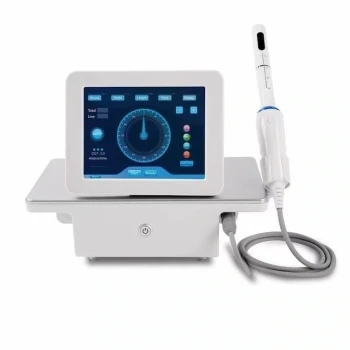Yes, complications and side effects can occur with HIFU (High-Intensity Focused Ultrasound). While it is a minimally invasive procedure, its effectiveness relies on destroying tissue with focused heat, which can inadvertently affect nearby structures. The most common issues involve urinary function and sexual health, including more frequent or urgent urination, urinary leakage (incontinence), and erectile dysfunction.
High-Intensity Focused Ultrasound is a precision tool, but the prostate's proximity to critical nerves and urinary structures means there is always a trade-off. Understanding that risk is not zero—and why these specific side effects occur—is the first step to making an informed decision.

How HIFU Works and Why Risks Occur
The Principle of Focused Ultrasound
HIFU operates much like a magnifying glass focusing sunlight onto a single point. It uses ultrasound waves, harmless on their own, and converges them on a small target area within the prostate.
This concentration of energy creates intense heat (ablation), destroying the targeted prostate tissue without requiring a surgical incision.
The Anatomical Challenge: The Prostate's Location
The prostate gland's position is the primary reason these side effects occur.
It surrounds the urethra (the tube that carries urine from the bladder) and sits directly below the bladder itself.
Crucially, the delicate nerve bundles responsible for controlling erections run alongside the prostate. Any treatment targeting the prostate, including HIFU, carries a risk of affecting these adjacent structures through heat transfer or inflammation.
A Detailed Breakdown of Potential Side Effects
Urinary Complications
Immediately following the procedure, swelling and irritation are common. This can lead to temporary urinary issues.
- Frequency and Urgency: Irritation of the bladder neck can make you feel the need to urinate more often and more suddenly. This often improves as the area heals.
- Urinary Incontinence: Leakage of urine is a potential risk, though severe, long-term incontinence is less common with HIFU than with more invasive surgeries. It typically results from damage to the sphincter muscle at the base of the bladder.
Erectile Function
Damage to the neurovascular bundles that control erections is a significant concern for many patients.
The risk of erectile dysfunction (ED) after HIFU depends heavily on the location of the tumor and whether a nerve-sparing approach is possible. If the targeted tissue is very close to these nerves, the risk of heat damage increases.
Less Common but Significant Risks
Other complications, while less frequent, are also possible and should be understood.
- Infection: As with any medical procedure, there is a risk of urinary tract infection.
- Urethral Stricture: Scar tissue can sometimes form in the urethra, causing it to narrow. This can obstruct urine flow and may require a separate procedure to correct.
- Pain or Discomfort: Post-procedure discomfort in the perineal or rectal area is possible but usually temporary.
Understanding the Trade-offs
The Appeal of a Minimally Invasive Approach
The primary benefit of HIFU is that it is less invasive than traditional surgery like a radical prostatectomy.
This generally means less blood loss, no surgical scar, and a faster recovery time. The goal is to achieve effective cancer control with a lower impact on quality of life.
Comparing Risk Profiles
No treatment for prostate cancer is without risk. Radical surgery and radiation therapy also carry significant risks of urinary incontinence and erectile dysfunction, often at higher rates than HIFU.
The key difference lies in the mechanism of potential damage. With HIFU, it is precise thermal energy; with surgery, it is the physical cutting and removal of tissue.
The Critical Factor of Operator Skill
The success of HIFU and the rate of complications are highly dependent on the skill and experience of the physician performing the procedure.
An experienced operator is better able to accurately map the prostate, define the treatment zone, and minimize the thermal margin affecting healthy tissue, directly impacting your outcome.
Making an Informed Decision
Choosing a treatment path requires balancing the goal of cancer control with the potential impact on your quality of life. Your personal priorities are paramount.
- If your primary focus is preserving erectile function: Discuss nerve-sparing HIFU techniques with your doctor and inquire about their specific experience and success rates.
- If your primary focus is minimizing urinary side effects: Understand that temporary issues are common, but the risk of long-term, severe incontinence is generally lower with HIFU than with radical surgery.
- If your primary focus is the most aggressive cancer eradication: Discuss whether HIFU is appropriate for the stage and grade of your cancer, as it is typically best suited for localized disease.
Ultimately, a thorough conversation with your urologist about the specific risks and benefits as they apply to your unique situation is the most critical step.
Summary Table:
| Potential Complication | Commonality | Key Considerations |
|---|---|---|
| Urinary Issues (Frequency, Incontinence) | Common (often temporary) | Results from swelling or irritation of the bladder neck and urethra. |
| Erectile Dysfunction (ED) | Varies (depends on nerve-sparing approach) | Risk is tied to proximity of cancer to neurovascular bundles. |
| Infection | Less Common | A risk with any procedure involving the urinary tract. |
| Urethral Stricture | Less Common | Scar tissue formation that may require further treatment. |
Making the right choice for your patients requires the right technology and support.
At BELIS, we specialize in providing medical aesthetics clinics and premium beauty salons with advanced, reliable equipment. Our expertise ensures you can offer treatments with confidence in both safety and efficacy.
Let's discuss how our professional medical aesthetic equipment can enhance your practice and patient outcomes.
Contact our specialists today to learn more
Visual Guide

Related Products
- 12D HIFU Machine Device for Facial HIFU Treatment
- 4D 12D HIFU Machine Device for Skin Tightening
- 7D 12D 4D HIFU Machine Device
- 22D HIFU Machine Device Facial Machine
- Vaginal Tighten HIFU Gynecology HIFU Treatment
People Also Ask
- How long does it take for HIFU to start working? See Full Results in 2-3 Months
- What are the benefits of HIFU machine? Achieve Non-Surgical Skin Lifting & Tightening
- How frequently should you do HIFU? Optimize Your Results with the Right Schedule
- How often should you do HIFU? Optimize Your Treatment Schedule for Lasting Results
- Is HIFU skin tightening safe? Ensure Your Safety with a Qualified Professional



















